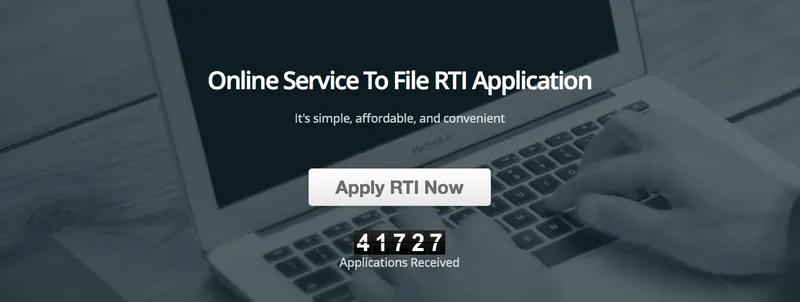OnlineRTI is simplifying RTI application procedure, aims for 1-lakh successful cases by 2015
The Right to information act has been one of the most powerful tools that Indian democracy has handed its citizens. Today, it's your right to seek information from the government and the officials. But it’s not as easy as it sounds.
Citizen’s RTI movement in India is one of the most successful and active movements that is bringing a great revolution for transparency in India.
This made Pradeep Bhatt and Vinoth Ranganath think about simplifying this whole procedure of applying for RTI online given the different parameters associated with it.
According to them, “Filing an RTI application is a very tedious process. We wanted to simplify and create a unified interface where users from across India can file their RTI applications.”
Why OnlineRTI?
Vinoth had a bitter experience applying for RTI, which is when this thought to structure the process first came to his mind. He was in Singapore then, and wanted to file an RTI Application with the central government and one with Tami Nadu’s state government. He had to go through many pages to understand the various amounts associated and payment modes – whether it was Indian postal order, DD, court fee stamp or cash.
He also had to further figure out the format in which an RTI application was to be filed. This procedure isn’t the same across the country making it difficult for most applicants. The mandatory formats in which the applications have to be drafted vary from state to state.
For one of his RTIs, he had to spend a lot of time finding out where to send the application. Vinoth needed to research the ways to ask questions properly, lest his RTI is rejected completely or the information they provide is incomplete and/or irrelevant. If the questions are not structured and framed well and the questioning logic is not simple, then RTI response is not satisfactory. He studied and analyzed the best practices recommended by some of the NGOs to seek the right answers.
This whole experience made him realize the hurdles in the path of anyone applying for an RTI. He was convinced that if the process was not simplified the number of applications would definitely go down. Apart from being time consuming, the process was complicated, unless the applicant was well versed in governance. Today, the team has raised a funding round of Rs. 50 lakhs through LetsVenture to fuel their expansion plans.
Online RTI helps with the process of filing RTI applications. They simplify RTI for every Indian citizen, regardless of location, social strata, or economic background. This team has made it possible for every citizen to use their right to seek information in a very simple manner.
Does RTI really work?
If you were to compare the implementation of such a right to information across various other democracies in the neighbourhood, RTI works very well in India. Today, every government office is required to have a dedicated PIO (Public Information Officer) whose primary responsibility is to duly respond to every RTI application.
There is also a process of first and second appeals (escalation) to the respective appellate authorities for all government bodies. In case of a delay in the response or an unsatisfactory response to an RTI application, the RTI applicant can choose to apply for a first appeal and subsequently for a second appeal as well. These appeals are part of the process of escalating the RTI appeal process.
Thus, with the RTI Act, it is part of the basic rights of every Indian citizen (now PIO and OCI card holders as well) to get his/her questions answered by the government and related organizations in a timely and comprehensive manner.
If a citizen poses his/her questions properly, follows the RTI rules of govt bodies, and sends it to the correct PIO/address, then he/she receives answers in most cases.

Impact
One can’t deny the impact RTI has brought in the system. It has helped people understand the functioning of government better, has helped to reduce, if not eradicate, corruption to a great extent.
Giving a sneak peek into their database, Vinoth shares that many pending cases of passports are today cleared thanks to OnlineRTI. He candidly shares a case where a passport application that was struck for over six months but got cleared within 10 days of filling an RTI. There are enough cases of pending Income Tax refunds, PF withdrawals and transfers, etc.
OnlineRTI has been helpful to bring out various shocking details out to the public today.
We know how difficult it is to get into IIMs. Can anyone imagine that the cutoff percentile scores for candidates to get admitted to IIM was 38.84 for SC/ST category? Deepak Mehta, one of the 100 percentile scorers who went to IIM-A, had applied for an OnlineRTI to know the lowest percentile score of a candidate that was granted admission to IIM.
If you happen to get a chance to watch the last season of ‘Satyamev Jayate’ episode on RTI, you would have seen Amir Khan endorsing the efforts of OnlineRTI.com
Today, an average user spends close to three minutes on their platform for an RTI application. Their internal RTI ERP system processes the application using the best practices and processes algorithm, and then it is applied.
Till date, the team has processed close to 12k RTI applications.
Speaking about the impact, Pradeep shares, “We want to simplify RTI application procedures and remove hurdles as much as possible. You do not have to stand in long queues at government offices to seek clarifications. You no longer need to bribe officials and clerks to get your work done. It's a democracy and every citizen has the right to know what’s going across various government bodies.
Changes expected in RTI
The team believes that RTI fees and mode of payment varies across states, and needs to be well structured. Today, fees range from Rs. 10 to Rs. 250 creating a lot of confusion for first timers.
There are different rules regarding the number of words an application can have. RTI needs to get formalized across the country and this state-to-state different models need to be abolished. There should be just one set of rules for the whole of India, independent of states and government offices.
Another major problem that applicants face is outdate addresses of many government offices on their websites. This needs to change and citizens need to keep updated about these changes from time to time. Such negligence on government’s part isn’t acceptable. Citizens would benefit a lot if websites were updated periodically. Also, as per Section 4(1) of RTI Act 2005, government bodies should disclose as much information as possible on their websites, but this has not yet been implemented.
With growing Internet penetration in India and reducing prices of smartphones, more people now have access to Internet. But we don't have enough regional content related to RTI and other government machineries available online. The government needs to make efforts to have their information available in both vernacular language as well as English.
Efforts need to be made to educated and teach the employees involved with answering citizens’ queries. There should be more Information Commissioners to avoid long list of pending appeal cases. Available resources need to be used prudently to clear appeals as quick as possible.
Future developments
The team believes in a vision to promote good governance and to bring transparency by promoting RTI Act with easy, accessible and effective tool to make an impact in the country.
OnlineRTI is testing new features on its platform like giving the freedom to users to apply for a RTI via phone calls. Most places in India still lack Internet and phone seems to be the most reliable mode of communication for majority of the population. This feature is being tested in Karnataka and Maharashtra.
They have set a goal to reach one-lakh RTI successful applications by end of June 2015. It isn’t ambitious given the efforts they have put in to create awareness about the whole initiative.
RTI has shifted the power-balance towards the citizens, and startups like OnlineRTI are making sure that citizens don't have any hurdles in their path to exercise their rights with ease.
Visit their website here.







